When the original Volkswagen Beetle appeared on the North American market in 1949, it had no right to be a sales success. Let’s face it, the car was small, its engine was at the wrong end, and not to put too fine a point on it, it looked weird when compared to its competition. So, did it take the market by storm in that first year? Er, no. Total Beetle sales for that first year amounted to precisely two vehicles. It would have been easy for Volkswagen to wave the white flag and go home with its tail between its legs. Eventually, the buying public realized that while it was small, the Beetle could comfortably seat four adults or two adults and three children. It was cheap to buy, even cheaper to run, and once it wound up its rubber band, it could cruise competently on the open road at 60mph. Thanks to these factors and an inspired advertising campaign, consumers realized that it made the perfect second car in a two-car household and that it was a worthy first car for many people who would otherwise have been forced to consider secondhand options. Today, the Beetle has a cult following, and tidy examples can fetch some extraordinary prices in the classic market. That leads us to our feature cars. The owner has a pair of Beetles, and he won’t separate them. While that often inspires the notion that one could serve as a restoration project while the other could constitute a ready supply of parts, that isn’t the case with these little gems. Both appear to be complete, and both are structurally sound enough to represent promising project builds. If that sounds too tempting to resist, you will find the Beetles located in Collingswood, New Jersey, and listed for sale here on eBay. The owner has set the BIN at a competitive $6,200, but he leaves the option open to make an offer.
The white Beetle is the newer of this pair and rolled off the production line in September of 1971. While its panels sport a few minor dings and marks, nothing there might have the buyer seeking replacement steel. There is evidence that the car has received a repaint in its original shade of Pastel White, although a repeat performance wouldn’t go astray if the car is to present at its best once again. It appears that all of the exterior trim is present, while the glass is in good order. The best piece of news is when we delve below the surface of this classic. The owner states that there is no rust on the underside, making this Beetle a prime candidate for a straightforward restoration project.
The blue Beetle is slightly older, with a build date of September 1970. The first thing to note is that it didn’t start life wearing Blue. Somebody has performed a color change, and they weren’t focusing on attention to detail when they performed the work. There are plenty of spots where its original Yukon Yellow is clearly visible. The buyer will probably decide to strip away the existing paint if they seek a high-quality finish. Once again, its panels have accumulated some minor dings, but these appear to be repairable. As is the case with its shed-mate, the exterior looks complete, and the glass seems to be okay. It shares one other important trait with its sibling; The owner says that this car is just as rust-free, meaning this is also a strong candidate for a project build.
Both Beetles are mechanically complete and feature drivetrains that are standard Volkswagen fare. That means that they feature a 1,585cc air-cooled flat-four engine that sends its power to the road via a 4-speed manual transaxle. While the ’70 model would have produced 57hp in its prime, running changes saw that number climb to 60hp for the following year. Neither figure is dazzling, but they allowed the Beetle to cruise effortlessly on the open road at 60mph while returning fuel consumption figures well north of 35 mpg. Reviving these two classics might not be difficult because both of their flat-fours last roared into life around two years ago. Once coaxed into a running state, the buyer might be able to return them to the road with little cost or effort. That opens the possibility of enjoying the cars immediately as survivors. It also opens the way for another tantalizing idea. Each of these Beetles would be worth considerably more in a roadworthy state than they are at present. If the buyer could achieve this with one car and then sell it, that would recoup some of the original purchase price or provide a nice war chest for restoring the other. It’s a point that is worth pondering.
The owner only supplies interior shots for one of these cars, but both will require a complete restoration if they are in a similar state. The radio is missing from the white car, but otherwise, it looks to be complete. For potential buyers, this is one of the areas where these Beetles come into their own as project cars. The affordability of replacement parts can be driven quite heavily by sales volumes. With the VW being so common and such a popular choice for project builds, interior trim kits are easy to find and surprisingly affordable. Whipping each interior into shape should cost under $1,000, and the kits that achieve this will contain every piece of upholstery, clip, screw, and nut that the owner would require.
It is said that from little things, big things grow. That was the case with the Volkswagen Beetle. While its American sales figures were initially dismal, clever marketing and perseverance saw this figure grow beyond 160,000 per year in less than a decade. This is particularly credible when you consider that by the time VW achieved this figure, the Beetle had received little more than a few minor styling and engineering changes in more than a decade. Today, they have a strong following in the classic market, and their stature has only continued to grow since the last example rolled off the production line in Puebla, Mexico, on July 30th, 2003. It drew the curtain on one of the best-selling cars to ever grace showroom floors, and many enthusiasts mourned its passing. Someone has the chance not only to own one Beetle, but they could have a matching pair. Would you restore one and sell the other, or does the chance to own a pair appeal to you? More importantly, are you tempted to contact the owner so that you can park these gems in your workshop?
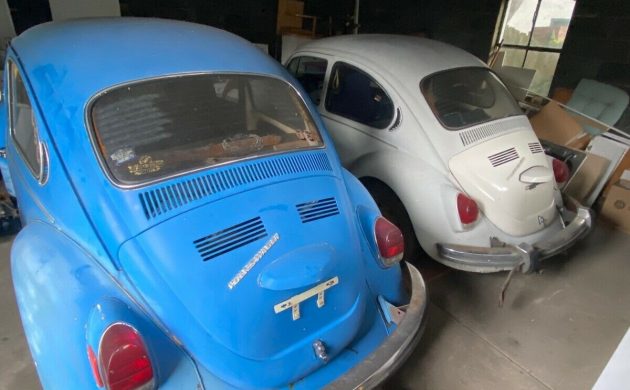
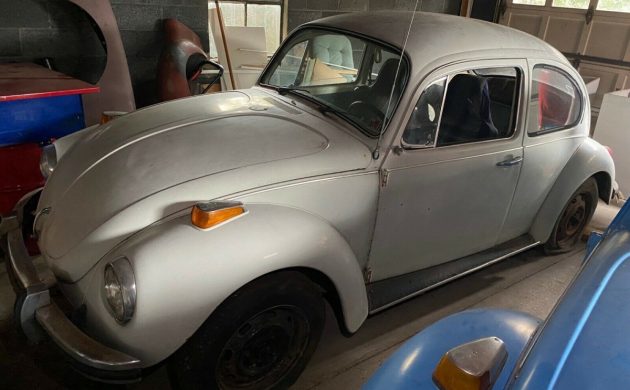
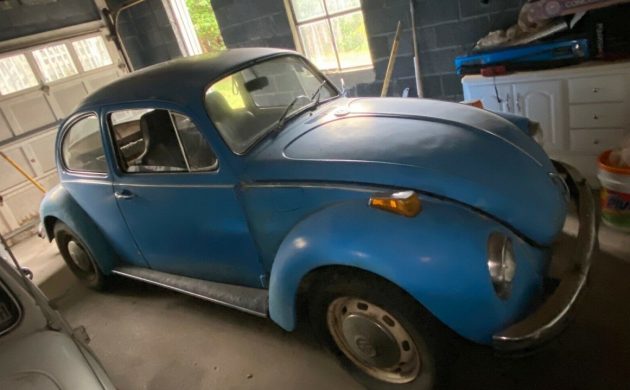
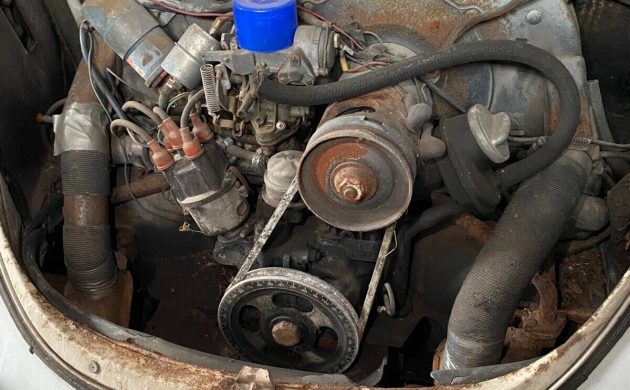
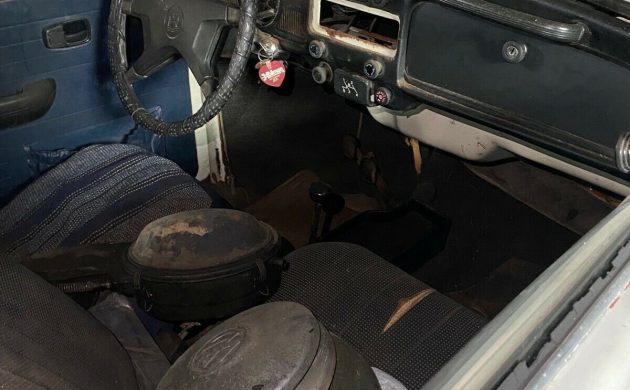
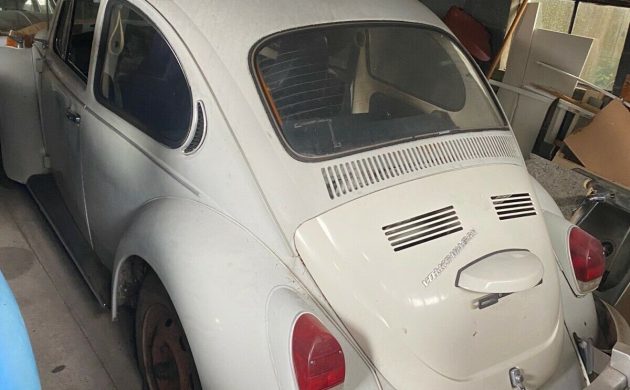
They are both 71 Super Beetles. As far as rust is concerned I take the statement no rust underneath with a grain of salt (pun intended). Cars come from the part of the country where I lived and worked as a tech with a PA inspection license. Most of these were gone by the time the 1990 inspection sticker was placed on the window. Most of the beetles rusted up at the frame head and frame horns which held the power train and lower control arm mounts up front. You will need to jack these up and really look them over. As far as missing titles that might be more of a hassle than it’s worth.
Didn’t super beetles have the larger taillight lenses?
All Beetles had to use the elephant style tail lamps as required by NHTSA in 73 along with heavy impact bumpers.
“All Beetles had to use the elephant style tail lamps as required by NHTSA in 73 along with heavy impact bumpers.” In his earlier comment alpphasud states both are ’71 models, so neither would be covered by this statement.
Hey they don’t have titles, some states like Fl. Can be a real problem. Look like flat windshields so not super bugs but clean used cars in the rust belt well better to have someone inspect.
71 and 72 Super Beetles had flat windshields same as the standard Bug. 73 was the first curved windshield Super.
NJ is a title state. I live 5 miles from these cars and the no title is an issue.
I owned one and only one VW Super “shimmy” Beetle and will never forget the curved glass missing from these two.
They are 1971 and 1972 models according to the VIN on each. I don’t know the difference between the regular and super from the pictures. The curved windshield wasn’t introduced until the 1973 model year.
Just the name..Super Beetle cracks me up. I keep picturing a little cape by the back windshield. Did I mention weed is legal in my state?
Just bought a 2009 Beetle and they are still a good inexpensive, second vehicle. A little small for the family, but my better half fits well in it. Much more power with the 2.5 power plant, than the pusher motors of the early days.
The only similarity is the VW logo.
There’s a distinct difference between a 09 and a 71 !
You are correct Charles, but I was just referencing to the brand and purpose of the Beetle. As the Dodge Dart of today compare to the Dart of Yesterday. Many forget the Beetle was Germany’s answer to the Jeep during WWII or maybe the other way around, a low cost and low maintenance, dependable off road vehicle. The rear engine was developed for traction off road. The jeep had the lite weight motor and all wheel drive for the same purpose.
Well dang it if they weren’t so far away I would buy them, current price is good and they are easy to fix. In my area I could sell each of them for this asking price for the pair.
I’m no expert on VW Beetles, but I did own a ’74 Super Beetle at one time. IIRC, the one distinction that was clearly visible was the distance from the front trunk opening to the windshield. On the Super Beetle it was about 5-7”. By that measure, neither of these are Super Beetles.
FWIW…
Yes, The Super Beetle was longer in front.
Clearly by the dates those would be a 71 and 72 but it looks like the one engine shot is a single port witch would make that a 70.
As per the photos. I think the white one might be a Super Beetle The Trunk lid was much wider at the Bottom. Supers had a much bigger trunk and McPherson strut suspension. The Blue one is even more iffy.
Actually Ken I believe it’s the other way around. The Blue one I’d definitely a Super. I thought the white one was a standard Beetle but the interior shot shows the electric blower fan that only the Super had. As far as single port someone might have changed it at some point in its life. The 2 slot engine lids were 70 and 71 only. I have a 71 Super FWIW.
Dad paid $500 in 1979 for a 71 Beetle; my first car. Badly rusted, so I’d really closely inspect these two, as most of these rusted out but still ran great. None the less, a buddy and I put a rebuilt engine in it in 1982 or so. We were so impressed that we put a rebuilt engine into his 1969.
Reliable, economical, simple to troubleshoot and repair, inexpensive and plentiful parts. I’d probably still have it if it wasn’t so badly rusted. The driver’s seat was just a few hard bumps from falling through the floor! My neighbor bought it and parted it out for his bug.
Lots of stories for anyone who owned one of these!
A 1972 model would have had 4 hood vents.
I would be concerned with no titles. But I am sure with some research it is possible to get them titled. Unless they are stolen.
I have a 76 standard beetle with the electric fan
Did anyone here who had a VW ever get ” well north of 35 mpg”? My 70 sure never did. I bought it used, for my wife, in 1974 with 55K miles after hearing all of the praises of how great Beetles were. A few months later the person I bought it from asked me how I liked it, and I told him it was OK but the 24MPG was a big disappointment. He said “are you getting 24, I never got that much”. Several of my co-workers had Beetles and talked about what a great car they were. The first day at work after buying mine I told one of the most ardent supporters of VWs that I had purchased one. He sked how many miles it had, and when I said 55K. he frowned and said “that’s about when mine started giving trouble”. It was not a good car and had virtually no heater but my wife was OK with it so I kept it until she wanted something better.
Yeah, I wasn’t going to say anything about the mileage. No way they got 35. I seem to recall I was getting about 23 or so.
You forget they don’t have heaters, they have heat exchangers to draw off excess heat from the exhaust manifold. Below about 20, there isn’t any excess heat.
I saw an example of the auxiliary heater that sat on top of the gas tank. Looked like one of them salamander heaters. I’m sure it heated well as long as you didn’t blow yourself to kingdom come.
Oh, I have lots of stories about cold weather and no heat. The Germans were tough in those days.
I’ve had quite a few Volkswagens in the last 49 years. I currently have a 67 Bug that I bought in 1982 and was my daily driver for about 15 years, Many years ago I put a 1965 (40 HP) motor in. it Mostly as an experiment, and if I drove like I was trying to get the best mileage possible, it easily returned 35 MPG. But these cars are a blast to drive and after my little experiment I put my 1600 DP back in.
But still, even driving it the way I like to drive I still got at least 25 MPG.
Hello,
This is my first post to Barn Finds. I enjoy reading about cars, especially classic VWs!
Regarding the white Beetle, I thought that its steering wheel’s “padded” design debuted in 1972.
A commenter, “Beel”, pointed out that the 1972 Beetles have four vents in the decklid. Does the white Beetle, then, have parts from several model years?
Would the crescent-shaped vents on the blue Beetle indicate that it is a ‘71 or later? By the time of its production date, 9/70, were any ‘70 Beetles still being produced?
I wonder if the buyer will be adding to an existing VW collection!
“These ones”? I am no English major but, I’m pretty sure that’s incorrect…..should say this pair. Love the bugs though!!
I don’t know about these later models but the only car that would start without a block heater in a Quebec winter in the ‘sixties was the VW beetle. Not only that it was a good snow car with its weight all above the drive wheels. A real trooper,
This is kinda tempting, even from all the way ‘cross country here in Reno, but the no title thing is really hinky to me. I wouldn’t have the first clue on how to even try to get them retitled. It wouldn’t be worth it if I couldn’t get papers on them.
You are better off finding one in your area. Trust me there is rust in them there Beetles critical areas.
The Super Beetle debuted in 1971 with strut front suspension and a flat windshield. Continued the same configuration for 1972. The curved windshield and a completely different dashboard debuted on the Super Beetle in 1973. Standard Beetles were also sold during these years. Another give away that the white car is a Super is the large bulge in the metal under the dashboard in the interior ebay picture. The year of the blue car is simple to identify by the VIN. The third digit being “1” means it is a 1971 model year. People are forever getting their years mixed up on Beetles, especially when you throw all the Super Beetle stuff in there too!! Don’t even get me started on folks who think the Super Beetle was some kind of a performance model with a different engine!